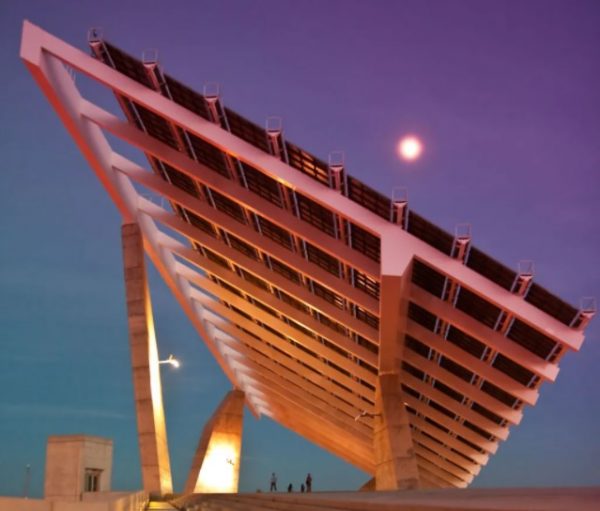Driven by steeply falling prices and technological progress that allows batteries to store ever-larger amounts of energy, grid-scale systems are seeing record growth. Many of the gains are spillovers from the auto industry’s race to build smaller, cheaper, and more powerful lithium-ion batteries for electric cars. In the US, state clean-energy mandates, along with tax incentives for storage systems that are paired with solar installations, are also playing an important role.
The mass deployment of storage could overcome one of the biggest obstacles to renewable energy – its cycling between oversupply when the sun shines or the wind blows, and shortage when the Sun sets or the wind drops. By smoothing imbalances between supply and demand, proponents say, batteries can replace fossil fuel “peaker” plants that kick in for a few hours a day when energy demands soar. As such, widespread energy storage could be key to expanding the reach of renewables and speeding the transition to a carbon-free power grid.
“Energy storage is actually the true bridge to a clean-energy future,” says Bernadette Del Chiaro, executive director of the California Solar and Storage Association.
How quickly that future arrives depends in large part on how rapidly costs continue to fall. Already the price tag for utility-scale battery storage in the US has plummeted, dropping nearly 70% between 2015 and 2018, according to the US Energy Information Administration. This sharp price drop has followed advances in lithium-ion battery chemistry to significantly improve performance. Battery capacity has expanded too, with facilities able to store and discharge energy over ever-longer periods of time. Market competition and rising battery production also play a major role; a projection by the US National Renewable Energy Laboratory sees mid-range costs for lithium-ion batteries falling an additional 45% between 2018 and 2030.
“We’re almost entirely piggybacking on the growth of lithium-ion battery technology, which is driven mostly by electric vehicles and consumer electronics,” says Ray Hohenstein, market applications director for Fluence, an energy storage technology provider with projects totalling nearly 1 gigawatt (1,000 megawatts) set to come online in California within a year. The money put into research for those applications is driving down costs across the board, says Hohenstein. “It’s just like what we saw with solar panels.”
In California, falling battery prices, coupled with the state’s aggressive push toward a carbon-free electrical grid by 2045, have led to a packed pipeline of storage projects. A 2013 bill set a target of 1.325 gigawatts of storage to be commissioned for the state’s grid by 2020. With 1.5 gigawatts of projects now approved – including more than 500 megawatts installed so far – that goal has already been surpassed, according to the California Public Utilities Commission.

When the gigantic Moss Landing project becomes fully operational in mid-2021, it will more than double the amount of energy storage in California. Several other states are also now embarking on major energy storage projects. Among them: New York’s 316-megawatt Ravenswood project will be able to power more than 250,000 homes for up to eight hours, replacing two natural gas peaker plants in the New York City borough of Queens. And the 409-megawatt Manatee system planned for South Florida will be charged by an adjacent solar plant. The facility, which utility Florida Power and Light says will be the world’s largest solar-powered battery system, replaces two aging natural-gas-fired units. As a whole, the US’s utility-scale battery power is set to grow from 1.2 gigawatts in 2020 to nearly 7.5 gigawatts in 2025, according to Wood MacKenzie, a natural resources research and consulting firm. Kelly Speakes-Backman, chief executive of the US Energy Storage Association, says that battery storage additions doubled in 2020, and would likely have tripled had it not been for construction slowdowns caused by the Covid-19 pandemic.
Europe has been slower to get on board with storage. “In general, Europe is a bit more conservative” when it comes to such developments, says Daniele Gatti, analyst for IDTechEx, a UK-based market research firm specialising in emerging technology. Energy storage development in Europe has been hindered by a restrictive electricity market dominated by government auctions that tend to undervalue storage, she says. Still, some big-battery projects are now taking shape, including the 320-megawatt Gateway system to be built at a new port facility near London.Globally, Gatti projects rapid growth in energy storage, reaching 1.2 terawatts (1,200 gigawatts) in the next decade. Key players include Australia, which in 2017 became the first nation to install major battery storage on its grid with the 100-megawatt Hornsdale Power Reserve, and is now planning to add another 300 megawatts near Victoria. The new system will dispatch electricity between states on an as-needed basis, maximising the efficiency of existing transmission infrastructure and reducing the need for building new power lines that would sit idle most of the time.

Similar projects are gearing up in Baden-Württemberg, south-west Germany. And while the US’s Moss Landing is set to be the world’s largest battery, it may be so for long. Saudi Arabia has just announced a bid for that title, with a massive solar-plus-storage system on the country’s west coast. The facility will provide 100% renewable energy around the clock to a resort complex of 50 hotels and 1,300 homes being built along the Red Sea.
With a recent report concluding that most fossil fuel power plants in the US will reach the end of their working life by 2035, experts say that the time for rapid growth in industrial-scale energy storage is at hand. Yiyi Zhou, a renewable power systems specialist at Bloomberg NEF, says that renewables combined with battery storage are already an economically viable alternative to building new gas peaker plants. Pairing electricity generation with storage works especially well with solar energy, which generally follows a predictable daily pattern. And, says Zhou, as more solar energy enters the grid, the cost of operating gas plants actually goes up.”That’s mainly because [gas plants] are forced to cycle on and off much more now because of solar penetration,” Zhou says. “This adds wear-and-tear, and shortens their lifetime.”Batteries are even beginning to reach a size – around 200 megawatts – that enables renewables to replace small- to medium-sized natural gas generators, says Fluence’s Hohenstein. “Now we’re able to truly build these hybrid resources – solar, storage, wind – and do the job that was traditionally done by fossil fuel power plants,” says Hohenstein, whose company is seeing a surge of interest in large projects.
Adding storage also makes renewable energy more profitable, says Wesley Cole, an energy analyst with the National Renewable Energy Laboratory. “One of the challenges of renewable energy is the more you put on the grid, the more the value declines,” Cole says. Storage helps deal with that by soaking up excess energy that would have been lost in the middle of the day, when electricity demand is lower, and moving it to a time when it is more valuable.
While energy storage is thriving in high-value markets, such as California, battery prices still need to come down more to reach large-scale global deployment. Yet analysts are optimistic that battery prices will eventually drop low enough for widespread energy storage use.
“We see storage being a large player across effectively every future we look at,” says Cole. “And not just one or two gigawatts… but tens to hundreds of gigawatts.”



 NepalPress
NepalPress















